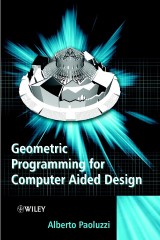Details

Geometric Programming for Computer Aided Design
1. Aufl.
|
130,99 € |
|
| Verlag: | Wiley |
| Format: | EPUB |
| Veröffentl.: | 30.01.2018 |
| ISBN/EAN: | 9781119509127 |
| Sprache: | englisch |
| Anzahl Seiten: | 815 |
DRM-geschütztes eBook, Sie benötigen z.B. Adobe Digital Editions und eine Adobe ID zum Lesen.
Beschreibungen
<p>Geometric Programming is currently of interest in CAD (Computer Aided Design) and related areas such as computer graphics, modeling and animation, scientific simulation and robotics. A growing interest towards gemotric programming is forecast in the next few years with respect to market specific CAD applications (e.g. for architecture and mechanical CAD) and web-based collaborative design environments.</p> <p>PLaSM is a general purpose functional language to compute with geometry which the authors use throughout their text. The PLaSM language output produces VRML (Virtual Reality Modelling Language) files which are used to create virtual worlds. PLaSM blends the powerful algebraic approach to programming developed at IBM research, with a dimension-independent approach to geometric data structures and algorithms, This book shows that such geometric code can be surprisingly compact and easy to write.</p> <p>It begins by introducing the basic programming with PLaSM and algebraic and geometric foundations of shape modeling, the foundations of computer graphics, solid modeling and geometric modeling of manifolds follows and finally discusses the application of geometric programming. For each topic, the mathematics is given, together with the PLaSM implementation (usually with a few lines of readable code) and some worked examples.</p> <ul> <li>Combines excellent coverage of the theory with well-developed examples</li> <li>Numerous applications eg. scientific stimulation, robotics, CAD, Virtual Reality</li> <li>Worked exercises for each topic</li> <li>Uses PLaSM language (supplied) throughout to illustrate techniques</li> <li>Supported with web presence</li> </ul> <p>Written for Industrial Practioners developing CAD software, mechanical engineers in Graphics, CAD and CAM, undergraduate and postgraduate courses in Computer Science and Mechanical Engineering,as well as programmers involved with developing visualization software.</p>
Preface.<br> <br> I Programming and Geometry.<br> <br> Introduction to FL and PlaSM.<br> <br> Geometric programming.<br> <br> Elements of linear algebra.<br> <br> Elements of polyhedral geometry.<br> <br> Elements of differential geometry.<br> <br> II Graphics.<br> <br> Affine transformations.<br> <br> Graphic primitives.<br> <br> Hierarchical structures.<br> <br> Graphic pipelines.<br> <br> Viewing and rendering.<br> <br> III Modeling.<br> <br> Parametric curves.<br> <br> Parametric surfaces and solids.<br> <br> Basic solid modeling.<br> <br> Dimension-independent PLaSM operators.<br> <br> Motion modeling.<br> <br> Appendix A: Definition of MyFont.<br> <br> Appendix B: PLaSM libraries.<br> <br> Appendix C: References.<br> <br> Index.
"...an ambitious text that covers a lot of ground...very suitable for postgraduate research and teaching..." (Computer-Aided Design, 2004)
<p><b>ALBERTO PAOLUZZI</b>, Department of Computer Science, Universita Roma Tre, Italy.</p>
<p><b>Learn how to create computational designs, graphics and animations with minimum programming effort but without sacrificing an understanding of the algorithmic processes involved.</b></p> <p>Students and teachers of computer aided design have two options available to them. On the one hand, they can make use of state-of-the-art computer aided design systems that hide all the programming behind the user interface. Alternatively, they can learn from first principles and expend excess effort dealing with the tangential programming requirements of the computational framework, the user interface and graphical display methods.</p> <p><i>Geometric Programming for Computer Aided Design</i> provides a middle way. It presents PlaSM, a design environment for graphics, modelling and animation that supports rapid prototyping but does not deprive the user of direct control over the underlying geometric programming.</p> <p>Divided into 3 self-contained sections, this book provides:</p> <ul> <li>An introduction to functional programming with PLaSM</li> <li>A comprehensive discussion of basic graphics programming techniques</li> <li>An in-depth tutorial on geometric modelling progressing from basic to advanced concepts including animation and motion modelling</li> <li>Complete PLaSM language libraries organized by chapter</li> <li>Access to free geometric libraries and the PLaSM source code via an accompanying web site</li> <li>Examples from other disciplines such as mathematics, mechanical engineering, architecture and the arts.</li> </ul> <p>Think of PLaSM as a Rapid Application Development environment that allows both student and teacher, professional designer and researcher, to generate examples and prototypes with minimal programming effort and maximum control.</p>
Diese Produkte könnten Sie auch interessieren:

Strategies to the Prediction, Mitigation and Management of Product Obsolescence

von: Bjoern Bartels, Ulrich Ermel, Peter Sandborn, Michael G. Pecht

116,99 €
















